The AMD Radeon RX Vega 64 & RX Vega 56 Review: Vega Burning Bright
by Ryan Smith & Nate Oh on August 14, 2017 9:00 AM ESTPower, Temperature, & Noise
Moving on from performance metrics, we’ll touch upon power, temperature, and noise. This is also normally where we’d discuss voltages, but as Vega is a new chip on a new architecture, nothing seems to read Vega 64 and 56 correctly.
In terms of average game clockspeeds, neither card maintains its boost specification at 100% with prolonged usage. Vega 64 tends to stay closer to its boost clocks, which is in line with its additional power overhead and higher temperature target over Vega 56.
| Radeon RX Vega Average Clockspeeds | ||
| Radeon RX Vega 64 Air | Radeon RX Vega 56 | |
| Boost Clocks |
1546MHz
|
1471MHz
|
| Max Boost (DPM7) |
1630MHz
|
1590MHz
|
| Battlefield 1 |
1512MHz
|
1337MHz
|
| Ashes: Escalation |
1542MHz
|
1354MHz
|
| DOOM |
1479MHz
|
1334MHz
|
| Ghost Recon: Wildlands |
1547MHz
|
1388MHz
|
| Dawn of War III |
1526MHz
|
1335MHz
|
| Deus Ex: Mankind Divided |
1498MHz
|
1348MHz
|
| GTA V |
1557MHz
|
1404MHz
|
| F1 2016 |
1526MHz
|
1394MHz
|
| FurMark |
1230MHz
HBM2: 868MHz |
1099MHz
HBM2: 773MHz |
With games, the HBM2 clocks ramp up and stay at their highest clock state. Expectedly, the strains of FurMark cause the cards to oscillate memory clocks: between 945MHz and 800MHZ for Vega 64, and between 800MHz and 700MHz for Vega 56. On that note, HBM2 comes with an idle power state (167MHz), an improvement on Fiji's HBM1 single power state. Unfortunately, the direct power savings are a little obscured since, as we will soon see, Vega 10 is a particularly power hungry chip.
As mentioned earlier, we used the default out-of-the-box configuration for power: Balanced, with the corresponding 220W GPU power limit. And under load, Vega needs power badly.
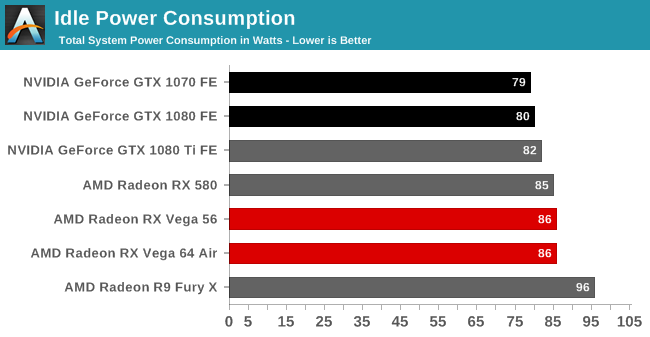
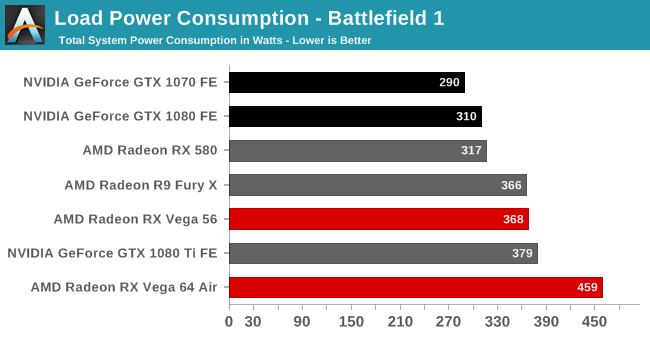
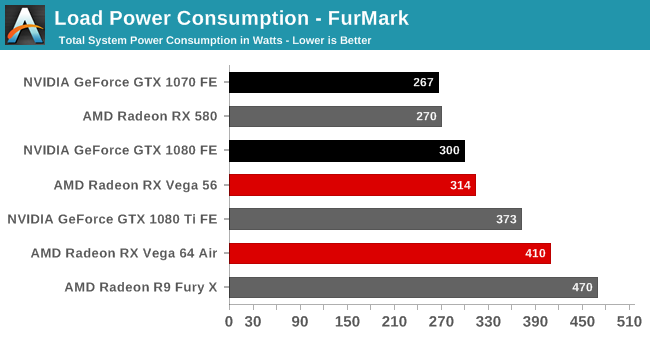
The performance of both Vega cards comes at a significant power cost. For the RX 500 series, we mused that load consumption is where AMD paid the piper. Here, the piper has taken AMD to the cleaners. In Battlefield 1, Vega 64 consumes 150W more system-wide power than the GTX 1080, its direct competitor. To be clear, additional power draw is expected, since Vega 64 is larger in both shader count (4096 vs. 2560) and die size (486mm2 vs. 314mm2) to the GTX 1080. But in that sense, when compared with the 1080 Ti, powered by the 471mm2 GP102, Vega 64 still consumes more power.
As for Vega 64's cut-down sibling, Vega 56's lower temperature target, lower clocks, and lower board power make its consumption look much more reasonable, although it is still well above the 1070.
In any case, the cooling solutions are able to do the job without severe effects on temperature and noise. As far as blowers go, RX Vega 64 and 56 are comparable to the 1080 Ti FE blower.
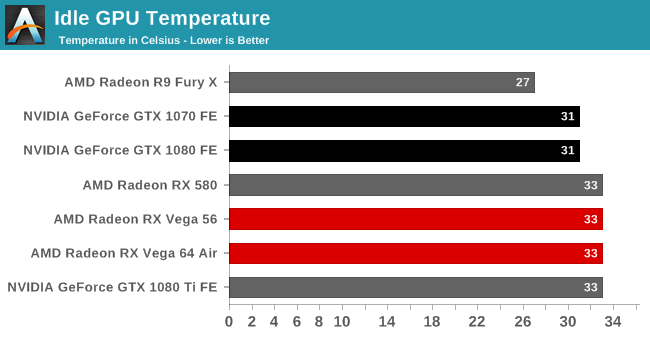
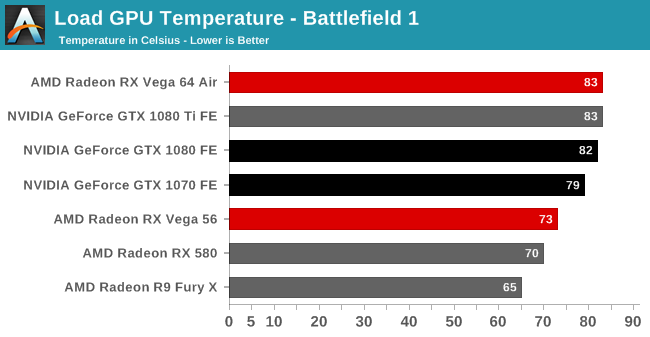

Not Graphed: Temperature of the actual Vega (Star): 9329C
Noise-testing equipment and methodology differ from past results, with a more sensitive noise meter and closer distance to the graphics card. Readings were also taken with an open case. As such, the noise levels may appear higher than expected.

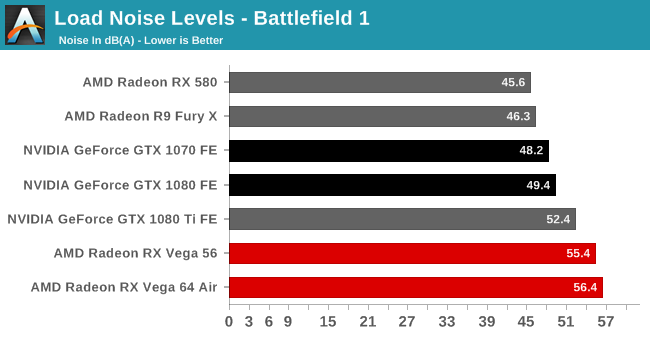
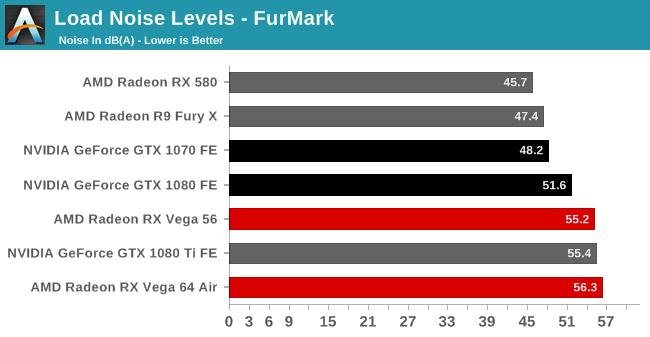










213 Comments
View All Comments
TheinsanegamerN - Monday, August 14, 2017 - link
Enough AMD fans will buy at inflated prices to make AMD some cold hard cash, then they will lower the price in 3 months.Aldaris - Monday, August 14, 2017 - link
It's still a competitor against the 1080.mapesdhs - Monday, August 14, 2017 - link
Not when it costs 100 UKP more (UK pricing). If the US pricing is as claimed, then I guess it's down to how much one cares about power/noise.xfrgtr - Tuesday, August 15, 2017 - link
the 64 does very poorly against the 1080darkfalz - Monday, August 14, 2017 - link
Not really. The x70 is usually 75% the performance of the x80. 25% is nothing to baulk at even if the price premium is much more than 25%.The 56 is something like 85-90% as fast as the 64 and significantly cheaper.
It's a shame this GPU arch is essentially DOA. Makes the wait for Volta much longer. Then again my 1080 is still giving me great performance and I'm CPU limited a lot at 1440p.
mapesdhs - Monday, August 14, 2017 - link
I think you're right, this will give NV more time to refine Volta, it'll sustain 10x0 sales for longer, so we'll have to wait for something better for those who want to move beyond the current 10x0 series.Da W - Monday, August 14, 2017 - link
Ryzen, Vega, Infinity fabric. The stage is set for a new fusion. Can't wait to see what their top 4-core + iGPU can do as a streamer box.tipoo - Monday, August 14, 2017 - link
It's surprising there still isn't even an APU as powerful as the PS4s GPU yet.Qwertilot - Monday, August 14, 2017 - link
They have, alas, no R&D money for that sort of 'side' project.msroadkill612 - Monday, August 14, 2017 - link
I hear nothing but good from folks who actually use amdS apuS appropriately. The 7850k was a classic for the money.Importantly, they have remained in the apu biz all along, and have the unique skillset to competently execute a new gen apu.
I wouldnt call mobile ryzen a side project. Its a cornerstone.